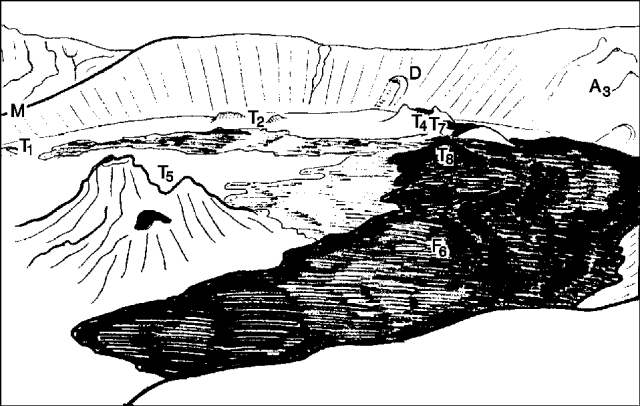Report on Ol Doinyo Lengai (Tanzania) — November 1988
Scientific Event Alert Network Bulletin, vol. 13, no. 11 (November 1988)
Managing Editor: Lindsay McClelland.
Ol Doinyo Lengai (Tanzania) Continued summit crater lava production
Please cite this report as:
Global Volcanism Program, 1988. Report on Ol Doinyo Lengai (Tanzania) (McClelland, L., ed.). Scientific Event Alert Network Bulletin, 13:11. Smithsonian Institution. https://doi.org/10.5479/si.GVP.SEAN198811-222120
Ol Doinyo Lengai
Tanzania
2.764°S, 35.914°E; summit elev. 2962 m
All times are local (unless otherwise noted)
Between 30 June at 2000 and early the next morning, a new cone (T8) had formed and emitted a large lava flow (F6) that reached the N and E crater wall (figure 10). On the afternoon of 26 July, a party visiting the crater noted lava in the E part of T4/T7, bubbling actively at some depth below the vent's edge. A new cone (T9) had formed a few meters from T5, and lava could be heard moving within the vent. The top of T8 had collapsed somewhat and no lava was visible inside. About five small flows, radiating from a source between T4/T7 and T8, were still warm and black and had probably formed within the last few hours. One flow had moved S and partly entered T1's overhang. Another flow had almost reached T2. No changes were observed on the crater walls or rim.
 |
Figure 10. View from halfway up Ol Doinyo Lengai's E crater wall, looking SW in the early morning of 1 July 1988. The crater floor is 200-240 m across. Tracing of a slide taken by C. Nyamweru. |
Geological Summary. The symmetrical Ol Doinyo Lengai is the only volcano known to have erupted carbonatite tephras and lavas in historical time. The prominent stratovolcano, known to the Maasai as "The Mountain of God," rises abruptly above the broad plain south of Lake Natron in the Gregory Rift Valley. The cone-building stage ended about 15,000 years ago and was followed by periodic ejection of natrocarbonatitic and nephelinite tephra during the Holocene. Historical eruptions have consisted of smaller tephra ejections and emission of numerous natrocarbonatitic lava flows on the floor of the summit crater and occasionally down the upper flanks. The depth and morphology of the northern crater have changed dramatically during the course of historical eruptions, ranging from steep crater walls about 200 m deep in the mid-20th century to shallow platforms mostly filling the crater. Long-term lava effusion in the summit crater beginning in 1983 had by the turn of the century mostly filled the northern crater; by late 1998 lava had begun overflowing the crater rim.
Information Contacts: C. Nyamweru, Kenyatta Univ.

